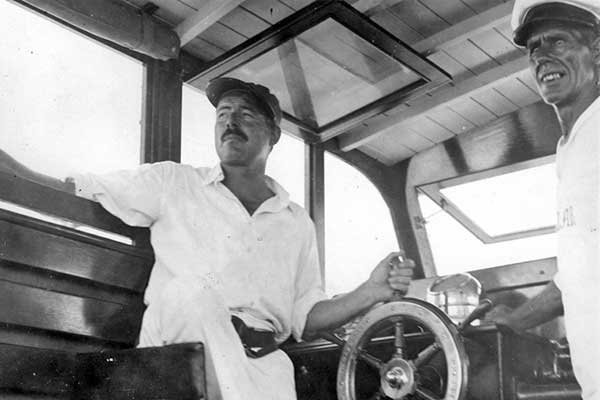
With Veterans Day recently passed, it reminded me of how a ragtag armada of everyday boating heroes kept World War II from America's coastline and became what we know today as the modern U.S. Coast Guard Auxiliary. Here's the story by Troy Gilbert.
From sailors to fishermen to power-boaters, ordinary citizens rose and volunteered themselves and their boats on every coastline of the U.S. becoming an integral defense force for the nation.
During a hot summer night in June 1942, the German submarine U-166 took aim at a U.S. Coast Guard patrol vessel escorting the passenger ship SS Robert E. Lee about 25 miles south of the mouth of the Mississippi River. Within an hour, the passenger ship would join the 56 other ships sunk off the northern Gulf Coast during World War II. Nearly 100 lives were lost on the SS Robert E. Lee, and the Coast Guard escort ship would claim the only sinking of a German submarine off the southern U.S. coastline.
In July 2014, the man who discovered the wreck of the Titanic, Robert Ballard, and a team of scientists aboard his exploration vessel Nautilus conducted a research expedition to study the long-term effects of the 2010 BP Deepwater Horizon oil spill. In the process, they documented many of these stricken World War II vessels, and a lost chapter in American maritime history emerged. Using remotely operated underwater vehicles equipped with high-definition cameras, many of these never-before-seen wrecks, some resting more than 5,000 feet deep, finally came in from the shadows and illuminated the straits in which the United States found itself during the early stages of the war. It was a situation that led to recreational boaters charging onto the frontlines to defend the country.
In 1941 after six U-boats managed to sink 41 ships in the targeted waters of the East Coast and the Florida Straits, a second, larger operation code-named Drumbeat was launched by the German navy, the Kriegsmarine. At the time, many U.S. citizens were still ignoring the calls for coastal blackouts by the government, which meant that the freighters and tankers that moved along the shores at night were conveniently silhouetted for the German navy. Taking advantage of that, an armada of 22 U-boats approached the U.S. coastline and the attacks were constant. In March 1942 alone, 70 American ships were lost to the U-boats on the U.S. East Coast and Gulf Coast, in what the Nazis terrifyingly referred to as the "American hunting season." This ongoing attack was kept largely secret from the American people by the U.S. government, which didn't want to admit how thinly stretched and outclassed the U.S. Navy and the U.S. Coast Guard were at this stage of the war — this despite several of the tankers exploding and burning for hours in plain view of port cities and their populations.
Finally, after many of the vital fuel ships supplying the Northeast were sunk, the oil and gas industry informed the U.S. War Department that the burgeoning war economy would grind to a halt from a lack of fuel in only nine months. There were 19 U-boats operating daily along the coastline; the U.S. government was under pressure, and at something of a loss, to counter the serious threat. At the time, the U.S. Navy was still ramping up the building of new warships, while the existing vessels were occupied with convoy patrols to England and with fending off the Japanese in the Pacific.
That was the critical moment when a surprising ragtag fleet of recreational boaters, the owners of schooners and powerboats, stepped forward. Immediately following the attack on Pearl Harbor, a small group of skippers offered up their personal boats for anti-submarine operations along the American coastlines, and these "coastal picket forces," made up entirely of civilian volunteers, eventually laid the groundwork for what became the modern-day Coast Guard Auxiliary.
Ernest Hemingway and the crew on board his 38-foot fishing boat, Pilar, were the most famous examples of this citizen force; Hemingway patrolled the Florida Straits in search of German U-boats while armed with only grenades and Thompson submachine guns. While Hemingway's actions certainly added to his legacy, he also gave a symbolic face to the thousands of American yachtsmen and yachtswomen volunteering their time and vessels to defend the coastline of the United States and the vital supply lines through the Caribbean.
By August 1941, it was reported that nearly every yacht club along the East Coast had banded together to form a flotilla. This civilian navy fleet was a true sampling of the boating traditions around the country, from yacht owners in the Northeast to shrimpers in the local flotilla toured the area on a 24-hour basis, enduring storms and the blazing heat of summer. Off the coast of Louisiana, a convoy of 126 shrimp boats had crew members on constant watch for submarines while continuing to bring in their hauls of Gulf shrimp.
The flotillas also became vital in rescuing seamen from torpedoed vessels, freeing up the Coast Guard to actively hunt marauding U-boats. In one instance, when a Mexican tanker lay engulfed in flames and rapidly sinking just off the beaches of Miami, hundreds of citizens watching in horror witnessed the local flotilla "drive their little boats right into the flames" to retrieve survivors.